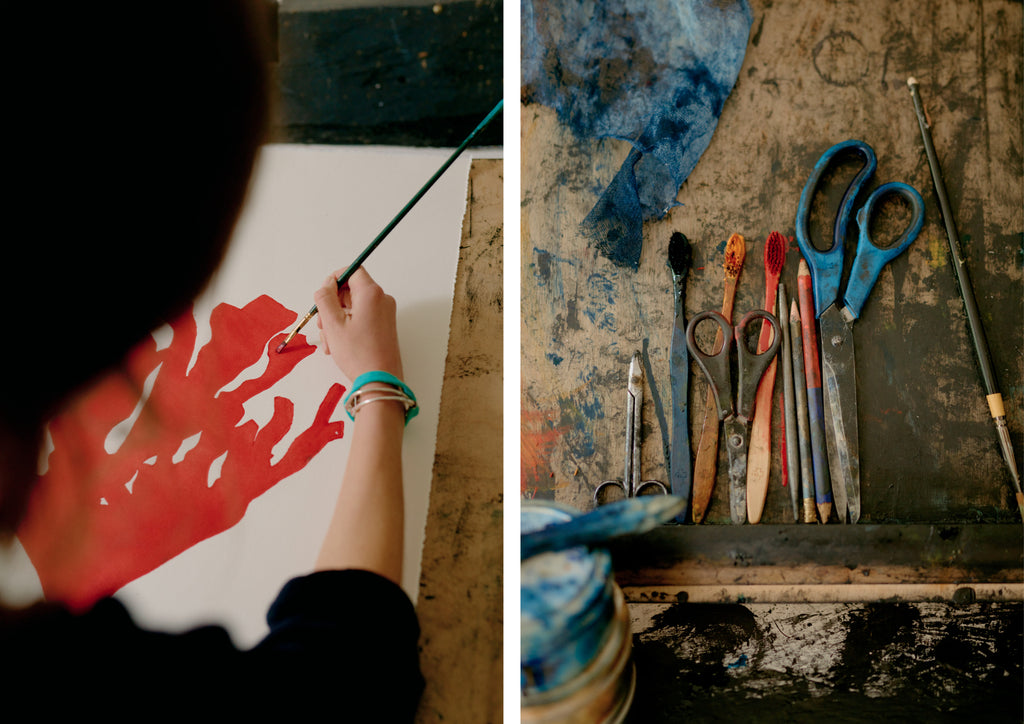
Did you know that when you take a deep breath, half the oxygen that enters your lungs is made by plankton? That when a Koala gives birth, the joey is the size of an unshelled peanut? That orcas are not whales, but the largest species of dolphin? That the saguaro cacti flowers smell like overripe melons? In her absorbing new book, Beatrice Forshall celebrates the planet’s most mysterious creatures and plants and urges us to do all we can to protect them. “I want to tell their stories,” says the artist and author, “because their story is our story, too.”
We’re chatting over Zoom, Beatrice from her studio, a small, corrugated shed in her garden situated on the edge of Dartmoor, in a pocket of wilderness surrounded by a farm. Over the past six months, she’s been home alone, working late into the night and slipping into bed with the dawn chorus. “I love hearing nothing but the owls, the patter of rain on the roof,” she says.

 The natural world has been at the heart of Beatrice’s practice since she was a child. It started with The Animal Club, which she founded, she tells me with a smile, aged nine. Every other week, she and a couple of friends would come together and make drawings and papier-mâché sculptures of endangered animals. “We would sell them at the local market and send the proceeds to the French World Wildlife Fund,” says Beatrice, who was born and raised in France before moving to the UK.
The natural world has been at the heart of Beatrice’s practice since she was a child. It started with The Animal Club, which she founded, she tells me with a smile, aged nine. Every other week, she and a couple of friends would come together and make drawings and papier-mâché sculptures of endangered animals. “We would sell them at the local market and send the proceeds to the French World Wildlife Fund,” says Beatrice, who was born and raised in France before moving to the UK.
Beatrice studied at Falmouth School of Art, where she specialised in drypoint engraving and completed a book about endangered British species as her final project. In 2018 she was artist in residence at the Cambridge Conservation Initiative, a global network of researchers and policymakers dedicated to sustainability. “I really worry about the planet and everything we’re doing to it, so it was encouraging to be in that environment, with people who have devoted their entire lives to looking after particular species,” she says.
 “The vulnerability of the species we endanger, their inability to speak for themselves, is what first made me want to make engravings of them,” writes Beatrice in the introduction to The Book of Vanishing Species. Each engraving starts out as a drawing on a large sheet of zinc. With a sharp tool, she scratches into the gleaming metal, then applies the ink; where there are incisions, the ink catches. After laying a sheet of dampened paper on top, she rolls it through the press and creates a series of about ten editions, each hand-painted with different colours. Flick through the book and you’ll glimpse a Bactrian camel glowing gold and the sooty outline of an Iberian lynx against a bright-blue sky. A wild salmon has smudges of red and blue-grey on its flanks.
“The vulnerability of the species we endanger, their inability to speak for themselves, is what first made me want to make engravings of them,” writes Beatrice in the introduction to The Book of Vanishing Species. Each engraving starts out as a drawing on a large sheet of zinc. With a sharp tool, she scratches into the gleaming metal, then applies the ink; where there are incisions, the ink catches. After laying a sheet of dampened paper on top, she rolls it through the press and creates a series of about ten editions, each hand-painted with different colours. Flick through the book and you’ll glimpse a Bactrian camel glowing gold and the sooty outline of an Iberian lynx against a bright-blue sky. A wild salmon has smudges of red and blue-grey on its flanks.
As Beatrice studied each species via texts, photographs and film, she was drawn into “their lives, their mystery, their otherness and their similarity to us”. She wanted not only to depict wildlife with engraved images, but also to write about each. Beatrice’s prose is as intricate as her pictures. The ploughshare tortoise has “placid but curious” lashless eyes and a domed shell decorated around the lower edge with “triangles like the fringe of a skirt, or bunting”.

As well as a beautiful celebration, this book is a call to arms. Beatrice writes about the olm: “This is a creature that has been able to survive the Earth’s collision with large meteorites, whatever wiped out the dinosaurs, and significant global climate changes; the fact it has been put at risk by the activities of the parvenu Homo sapiens is a measure of our destructiveness.” During the 18 months it took her to research the book, 107 species were declared extinct.
“As humans, we need facts and figures – but I think stories are what move people,” says Beatrice, who describes how each species breathes, eats, moves, communicates, nurtures its young. It’s easy to feel overwhelmed by the colossal threat the natural world faces, and these drawings and tales, beautifully balanced with light and dark, faith and urgency, are a way in. “My hope is that they enter readers’ hearts and minds, because you have to love something to be able to save it.”
Interview by Chloë Ashby, an author and arts journalist. Her first novel, Wet Paint, was published by Trapeze in April 2022.
Photographs by James Bannister.
The Book of Vanishing Species, written and illustrated by Beatrice Forshall, is published on 13 October by Bloomsbury Publishing.
Add a comment